IDEX Online Research: Net Decline of Specialty Jewelers in the U.S. Slows in 2007
January 30, 08
Jewelry industry consolidation in the U.S. decelerated in 2007 as fewer specialty jewelers went out of business. According to new data released by the Jewelers Board of Trade (JBT), the jewelry industry lost a net of only 349 specialty jewelers last year, with 601 merchants closing their doors forever, offset by 252 merchants who took the plunge and opened new jewelry businesses.
JBT figures also show that the census of wholesalers and manufacturers located in the U.S. declined not only by a slightly smaller number than in prior years, but the rate of decline also slowed.
Specialty Jewelers’ Closings Slow in 2007
During 2007, about 601 U.S. specialty jewelers went out of business, according to the Jewelers Board of Trade. This number was about 40 percent smaller than the prior year, when 1,106 jewelers closed their stores. During 2007, 252 merchants decided to open new jewelry stores in the U.S.; this was about in line with the prior year when 251 merchants decided to take the plunge and enter the jewelry industry. As a result of far fewer store closings, offset by a flat number of new store openings, the net loss of specialty jewelers last year – 349 businesses – was one of the smaller losses on record since IDEX Online Research began keeping records in the mid-1980s.
The graph below summarizes the number of specialty jewelers operating in the U.S., based on the JBT census. While JBT figures show approximately 23,449 specialty jewelers in the U.S. at the end of 2007, government census figures (both from the IRS and the Department of Commerce) will show a slightly higher number, when they are reported later this year (see Census table at end of article) due to differences in how each organization defines a “jeweler.”
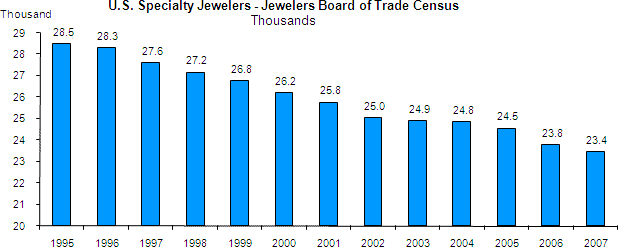
Source: Jewelers Board of Trade
The graph below summarizes the openings and closing of specialty jewelers in the U.S. over the past twelve years. In 2007, the number of jewelry stores which closed (red bar) dropped sharply from 2006 and was below the average for the past decade. The number of new jewelry store openings (green bar) was about in line with prior years’ levels.
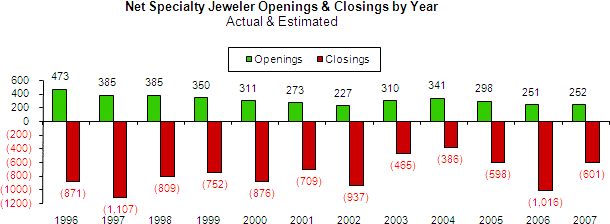
Source: Jewelers Board of Trade
Jewelry Bankruptcies at Record Low in 2007
After surging in 2005, bankruptcies by specialty jewelers moderated substantially in both 2006 and 2007. In 2007, only 54 jewelers suffered a “financial embarrassment,” defined by the Jewelers Board of Trade as “all those firms that encountered financial difficulties during the period. This includes bankruptcy filings, receiverships, assignments, arrangements, partial settlements, moratoriums, bulk sales where creditors were not paid in full, etc. Those firms arranging to pay 100 percent, however, have not been included.”
In part, this trend is due to a change in the bankruptcy laws in the U.S. in 2005. Until October 2005, it was relatively easy to file for bankruptcy and escape debt. However, after October 2005, Congress toughened the nation’s bankruptcy laws, making it much more difficult to file for bankruptcy and run from creditors.
Further, this positive trend in bankruptcies is due to a strong economy in 2006 and early 2007. When the economy is strong, jewelers’ sales usually show solid growth. Historically, jewelry failures usually begin to show up about a year after the economy softens.
The graph below summarizes the number of bankruptcies among U.S. jewelers since 1996, according to statistics from the Jewelers Board of Trade.
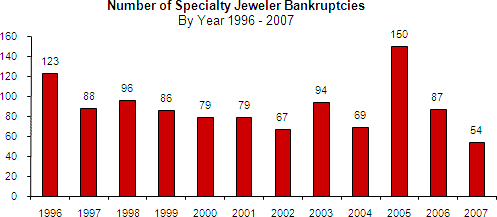
Source: Jewelers Board of Trade
Not only did the number of specialty jewelers who filed for bankruptcy decline significantly in 2007, but the average claim that creditors placed against specialty jewelers in the U.S. also fell. In 2007, the average claim was $6,333, down from the prior year’s record level of $6,546. In 2006, there was at least one huge claim which distorted the year’s numbers.
The graph below summarizes the size of the average claim placed against U.S. specialty jewelers by creditors who use the Jewelers Board of Trade as their collection agent.
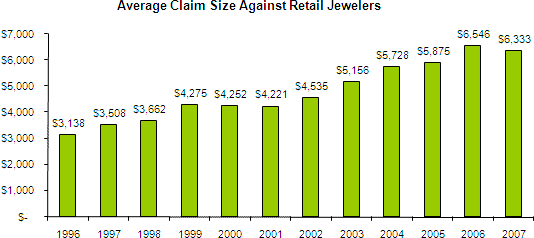
Source: Jewelers Board of Trade
U.S. Jewelry Wholesalers Decline in 2007
The number of jewelry wholesalers in the U.S. declined again in 2007, and stands at its lowest level since JBT began publishing its statistics. The number of jewelry wholesalers operating in the U.S. has been up and down over the past decade. In part, this is due to the ease of entry into the wholesale business.
Typically, jewelry wholesalers have a modest office and some inventory. They don’t invest in production facilities, nor do they have any retail outlets. Many are nothing more than traveling sales people who operate from their homes. Thus, when jewelry demand is strong, the number of wholesalers typically rises; when demand cools, some of those wholesalers simply go out of business and vanish.
The graph below shows the trend of jewelry wholesale businesses in the U.S., as reported by the Jewelers Board of Trade.
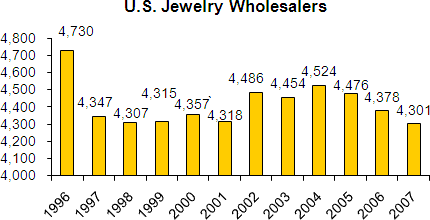
Source: Jewelers Board of Trade
For the past decade, the number of U.S. jewelry manufacturing businesses has been on a relentless decline. This is no surprise. Many manufacturers have moved their production operations offshore to countries where labor rates are much lower. IDEX Online Research believes that the number of manufacturers who actually have significant production facilities remaining in the U.S. is far fewer than shown by the Jewelers Board of Trade numbers. Many of the manufacturers shown in the JBT census appear to have corporate offices in the continental U.S., but no longer have any production facilities in the country.
The following graph illustrates the steady decline of jewelry manufacturers in the U.S.
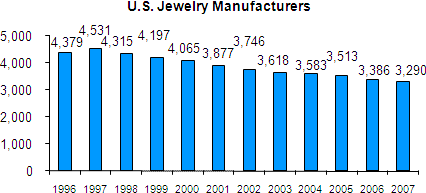 Source: Jewelers Board of Trade |
Outlook: More Specialty Jewelers to Fail in 2008
Based on historical trends and other research, IDEX Online Research believes that the net loss of independent specialty jewelers could reach 600 or more, with an equal decline in 2009. This implies a rate of new store openings of 250 or so, with closings of 850 or 900.
Three key trends have affected our forecast:
- Industry Consolidation – The U.S. jewelry industry is one of the last unconsolidated retail sectors. Unfortunately, it appears that retail consolidation is inevitable. It is difficult to find a retail sector which has escaped consolidation.
For much of the past ten years, chain jewelers have been pushing independents out of business. However, except for Sterling Jewelers (Kay, Jared and regionals such as J.B. Robinson), many of the chain jewelers in America have slowed their new store expansion plans recently. IDEX Online Research believes that, even without the push of chains, mom-and-pop jewelers are finding it more difficult to operate when competing against a whole new category of retailers who are selling jewelry – Wal-Mart, Kohl’s, Sears, and others. Based on the latest census figures, specialty jewelers’ sales represent only about 48 percent of total jewelry sales in America, a proportion that has been steadily declining. Further, mom-and-pop jewelers are burdened more than ever by government regulations (zoning, etc.). Finally, single-store independents cannot buy jewelry as efficiently as a chain jeweler; therefore, their merchandise offerings are typically not as competitive.
- Economic Pressure – When the economy of the U.S. is hot, the net number of jewelers closing their stores declines. When the economy slows, jewelry demand falls, and the marginal merchants are forced out of business. Typically, jewelry store closings lag a soft economy by about a year (see periods 1996-1997 and 2001-2002 on the graph below). Thus, if the U.S. economy enters a recession in the second quarter of 2008, it is likely that the number of jewelers who fail will spike in early 2009, perhaps right after the 2008 holiday selling season. The graph below illustrates the correlation between the change in the net number of jewelry store closings and U.S. Gross Domestic Product (GDP).
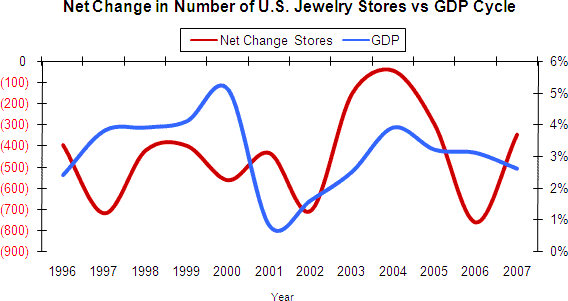
Source: Department of Commerce, Jewelers Board of Trade and IDEX Online Research
- Online Jewelry Merchants – Not long ago, we would not have mentioned online jewelry merchants as a threat to U.S. specialty jewelers. However, online jewelers have captured an estimated 3.9 percent market share (2006 data) of the total U.S. jewelry market, far ahead of most other retail categories. Of aggregate U.S. retail sales (all categories), only about 2.6 percent of sales are made online. Thus, online jewelry merchants have far more market share than online merchants in most other retail categories. Online jewelry merchants represent two threats to store-based jewelers: 1) lower prices; and 2) a new economic operating model. Online retailers such as Blue Nile sell diamonds less expensively than most store-based jewelers; young, internet-savvy consumers know how to find the best prices online. Further, online jewelers’ financial models are much more efficient, with higher inventory turns, negative working capital, and low (or no) debt. Until store-based jewelers begin to adopt some of the components of the online economic operating model, they will be operating at a competitive disadvantage.
How Many Specialty Jewelers Are There in the U.S.?
We regularly get asked how many specialty jewelers operate in the U.S. When we quote figures, we like to have at least three sources for our data. For the U.S. jewelry census, we have three reliable sources for census data: the Jewelers Board of Trade (JBT), the Bureau of Labor Statistics (BLS) and the Department of Commerce.
Census figures vary among these three sources due to differences in definitions. For example, the Jewelers Board of Trade defines chains such as Sterling, which currently has just under 1,400 stores in the U.S. as “one” jeweler. On the other hand, the Department of Commerce uses the term “jewelry establishment,” which is defined as “one store,” thus, Sterling represents nearly 1,400 of the “establishments” in the government census data.
The BLS census includes jewelers who make quarterly reports about wages and other labor information. Those jewelers who do not make quarterly labor reports are generally too small to be of consequence to the industry. Thus, while the math indicates that the JBT database includes about 91 percent of all U.S. jewelers, it actually includes just about every jewelry business of any consequence, in our opinion.
We continue to believe that JBT figures are the most reliable source for jewelry industry census trends. JBT statistics include only those jewelers who are of consequence. In contrast, the government figures include any person who reports that he or she may be in the jewelry business, even if it is a shell business designed for a tax write-off.
The table below summarizes jewelry store census figures from the three reliable, credible sources that supply IDEX Online Research.
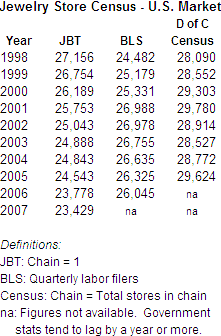
Source: JBT, BLS, Dept of Commerce
Today, our “official” answer to the question of “How many specialty jewelers operate in the U.S. market” would be: “There are about 23,400 companies operating just over 29,000 stores.” That’s our story, and we’re sticking with it.
Some people in the jewelry industry suggest that the number of specialty jewelers is far higher—we’ve seen numbers as high as 41,000. This number comes from mailing list suppliers which purport to have the names of all the jewelry stores in America on their lists. Unfortunately, those mailing lists are heavily padded. For example, IDEX Online Research is on many of those lists multiple times under various names – some different consulting names that we have used in the past as well as variations in the spelling of our name. Further, major chain jewelers have hundreds of employees on those “jewelry store” mailing lists; many of those names related to chains are not jewelry store managers.
In the past, we also relied on Roper for a cross-check of our jewelry store census. We no longer believe the Roper figures are reliable, since it appears that it may be using mailing lists as a basis for its census. Based on its most recent census data, Roper suggests that the industry has about 40,000 specialty jewelers. Because we have a database with the number of stores of nearly every jeweler with annual sales of $10 million or larger, we have determined that the Roper figures are too high.
There is only one “gray” area: operators of leased departments. While we have a location census for Finlay, the major operator of leased jewelry departments, we count Finlay as “one” in terms of stores. That was an executive decision which we made, and, until we can be persuaded otherwise, we’re staying with that decision.